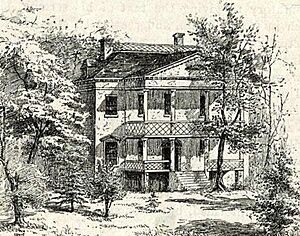Richmond Hill (Manhattan) facts for kids
Richmond Hill was a large, beautiful estate in Manhattan. It was built on land leased from Trinity Church in 1767 by Major Abraham Mortier. He was the paymaster for the British army in the colony. Today, part of this historic area is known as the Charlton-King-Vandam Historic District in Hudson Square.
Contents
History of Richmond Hill Estate
The Richmond Hill house stood near where Varick and Charlton Streets are today. It was also close to a path that connected the city with Greenwich Village. The house was a wooden building with a grand front porch. It had a high basement and steps leading up to the main entrance.
Famous Residents and Headquarters
Sir Jeffrey Amherst, a British military leader, used Mortier's house as his headquarters. This was at the end of the French and Indian War. Later, starting in April 1776, the estate became the headquarters for George Washington. He was the commander of the Continental Army during the American Revolutionary War. Washington stayed there until his army had to leave New York after the Battle of Long Island in August.
After the British occupied the house from 1776 to 1783, it was used by Sir John Temple. He was the first British ambassador to the United States. The house was empty for a while before becoming the official home of Vice President John Adams.
Abigail Adams's Description
Abigail Adams, John Adams's wife, loved the estate very much. She wrote about its natural beauty. She said it was "a mile and a half from the city of New York." The house was on a hill, with the Hudson River flowing nearby. She could see many boats on the river.
To her right, there were fields filled with grass and grain. To her left, she could see parts of New York City. Across the Hudson River, the New Jersey shores looked rich and well-farmed. Behind the house was a large flower garden. Old oak trees and wild shrubs surrounded the property. Abigail Adams found the spot truly enchanting. She also enjoyed listening to the birds singing every morning and evening.
Aaron Burr's Ownership
In 1794, Aaron Burr bought Richmond Hill as his country home. Burr had known the house from the start of the American Revolution. He had been an aide to General Putnam. A small stream called Minetta Creek formed a pond near Richmond Hill. In winter, this pond, known as "Burr's Pond," was a popular spot for ice skating.
A Visit from Joseph Brant
One day in 1797, Burr's fourteen-year-old daughter, Theodosia, was in charge of the house. She received an unexpected visit from Joseph Brant. He was a famous Mohawk chieftain. He brought a letter from Aaron Burr. Burr described Brant as "a man of education" and "quite a gentleman." He asked Theodosia to treat him with respect. Burr also suggested she give a small gift, like earrings, to one of Brant's daughters.
Changes to the Estate
On July 11, 1804, Aaron Burr left Richmond Hill to cross the Hudson River. He was going to his famous duel with Alexander Hamilton. In 1807, Burr planned to build new streets and houses on the property. The city council approved his plan. However, he did not have enough money to complete it.
Later, Burr's creditors sold the estate to John Jacob Astor. Astor was a very wealthy real estate businessman. He then sold parts of the land for building. In December 1820, Astor had the main house moved. It was rolled down the hill to a new location at Varick and Charlton Streets.
Richmond Hill as a Public Place
In 1822, Astor opened the house and its gardens to the public. It became a popular resort. People remembered it as a nice place to visit. In November 1831, the house became a theater. The next year, it was an Italian Opera House. After that, it hosted equestrian shows. Eventually, it became a common saloon. The historic Richmond Hill mansion was finally torn down in 1849.
During the time the mansion existed, the area around it was also called Richmond Hill. This neighborhood was built up by Astor starting in the 1820s. It had modest brick rowhouses. The area was connected to the city by a continuation of Canal Street.


